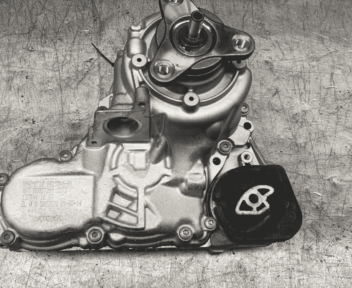Vous êtes-vous déjà demandé ce que signifient des expressions obscures, comme “volant d’inertie”, “usure des disques”, “plaque de pression”, etc. ? Le passage des vitesses n’existerait pas sans les acteurs clés qui composent l’embrayage. Ce petit monde mécanique bien huilé agit entre le moteur et la transmission pour éviter tout choc et assurer la fluidité de votre conduite.
Un service irréprochable
Boite de vitesses cassée ? Nous vous aidons à identifier et commander votre modèle

Quelle est l’utilité de l’embrayage ?
L’embrayage joue un rôle majeur pour votre véhicule. Sans lui, vous n’irez nulle part ! Il assure la liaison entre l’arbre de transmission et les roues. Sur une boîte de vitesses manuelle, lorsque votre pied gauche appuie sur la pédale d’embrayage, vous découplez temporairement le moteur de la transmission pour changer de rapport ou vous arrêter sans caler. En position embrayée, vous rétablissez cette connexion.
Une boîte automatique utilise un convertisseur de couple pour jouer ce rôle. Ce dispositif assure une transmission de puissance souple et continue entre le moteur et la boîte. Les systèmes à double embrayage, de plus en plus répandus, offrent une expérience de conduite plus sportive. Deux embrayages agissent en alternance pour des changements de vitesse plus rapides et presque imperceptibles pour le conducteur.
Les principaux composants du système d’embrayage
Le mécanisme d’embrayage est composé de plusieurs éléments clés, chacun jouant un rôle spécifique dans son fonctionnement :
- La pédale d’embrayage : c’est le point de ralliement qui commande l’actionnement du mécanisme ;
- Le disque d’embrayage : situé entre le volant d’inertie et le plateau-pression, c’est lui qui transmet le couple du moteur à la boîte de vitesses ;
- Le plateau pression : il plaque le disque contre le volant moteur lorsque la pédale d’embrayage est relâchée ;
- Le volant moteur (ou volant d’inertie) : fixé au vilebrequin, il tourne en permanence quand le moteur est en marche ;
- La butée d’embrayage : actionnée par le système de fourchette d’embrayage, elle appuie sur le diaphragme du plateau pression pour désengager l’embrayage ;
- Le mécanisme d’actionnement : Il transforme la pression de la pédale en mouvement en la reliant à la fourchette d’embrayage via un câble ou un système hydraulique.
Comprendre le mécanisme de l’embrayage
Le fonctionnement repose essentiellement sur le principe de friction. Lorsque deux surfaces sont pressées l’une contre l’autre avec suffisamment de force, elles tournent ensemble sans glisser.
En position embrayée
Le diaphragme, toujours en tension, pousse le plateau de pression contre le disque d’embrayage qui se retrouve comprimé contre le volant d’inertie. La friction est alors suffisante pour que ces trois éléments tournent en bloc, connectant ainsi le moteur à la boîte de vitesses.
En position débrayée
La butée d’embrayage pousse sur le centre du diaphragme, déformant sa courbure pour relâcher la pression du plateau. Le disque tourne alors librement, déconnectant le moteur de la boîte.
En engagement progressif (relâchement graduel de la pédale)
Au fur et à mesure que la pédale est relâchée, le plateau de pression reprend contact avec le disque. Cette friction croissante permet une reprise en douceur de la transmission de puissance. Cette phase d’adhérence est cruciale pour un démarrage sans à-coups.
Quels sont les différents types d’embrayages ?
Le choix de l’embrayage est un équilibre entre performances, coût, confort et attentes du marché. En voici les principales caractéristiques.
Embrayage mécanique et embrayage hydraulique
L’embrayage mécanique utilise un câble pour actionner le mécanisme de débrayage. Il est simple, mais peut nécessiter un réglage régulier. Son homologue hydraulique est basé sur un système de fluide sous pression (souvent du liquide de frein), il offre un meilleur confort et une moindre sensibilité à l’usure.
Embrayage monodisque et bimasse
L’embrayage monodisque est le plus courant dans les voitures particulières en raison de sa robustesse et de sa simplicité. Le bimasse a une action de ressort grâce à un volant moteur en deux parties qui absorbe les vibrations. Cependant, sa complexité rend son coût élevé et son entretien plus exigeant.
Quelle est la durée de vie moyenne d’un embrayage ?
En moyenne, un embrayage peut tenir entre 100 000 et 200 000 km. Le seul vrai ennemi de cette pièce est l’usure et sa durée de vie dépend de nombreux facteurs :
- Le style de conduite ;
- Le type de trajets ;
- La charge du véhicule ou le remorquage fréquent ;
- La qualité des composants ;
- L’entretien régulier du véhicule.
Pour maximiser la longévité de l’embrayage, adoptez une conduite souple, évitez de garder le pied sur la pédale d’embrayage lorsque ce n’est pas nécessaire, et faites vérifier régulièrement le système par un professionnel.
Comment détecter les manifestations d’un embrayage défectueux ?
Il est fréquent de confondre une panne d’embrayage avec une panne de boîte de vitesses, car certains signes d’usure provoquent les mêmes symptômes :
- Patinage ;
- Difficultés à passer les vitesses ou à-coups au démarrage ;
- Pédale d’embrayage anormalement molle ;
- Bruits anormaux ;
- Odeur de brûlé ;
- Vibrations.
En cas de problème, vous pouvez vérifier l’état du câble ou le niveau d’huile dans le réservoir de fluide d’embrayage. Mais sachez que seul un technicien spécialisé peut déterminer l’origine de la panne avec certitude en contrôlant tous les éléments de transmission.
Un embrayage défectueux peut entraîner une usure prématurée de la transmission, allant parfois jusqu’à provoquer des dommages irréversibles. Si le diagnostic de votre véhicule vous oriente vers l’achat d’une boîte de vitesses en échange standard, EDEN BOITES est votre solution ! Nous disposons d’un des plus vastes stocks d’Europe, couvrant toutes les marques et tous les types de transmissions.
Contactez-nous et bénéficiez de notre garantie et d’un service rapide !








